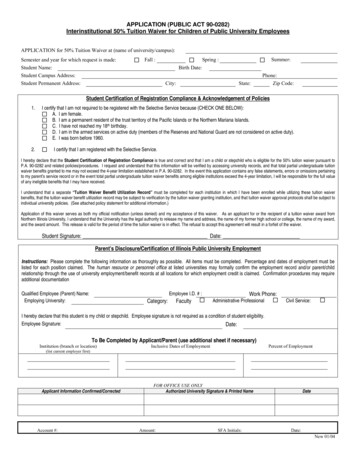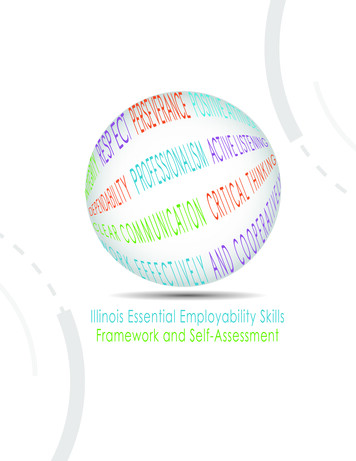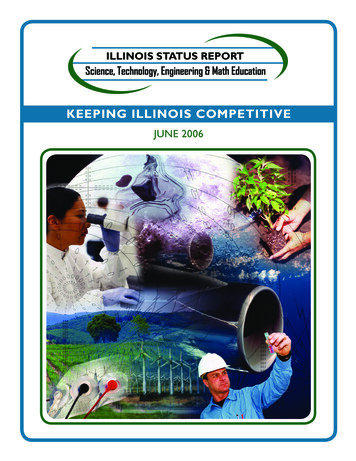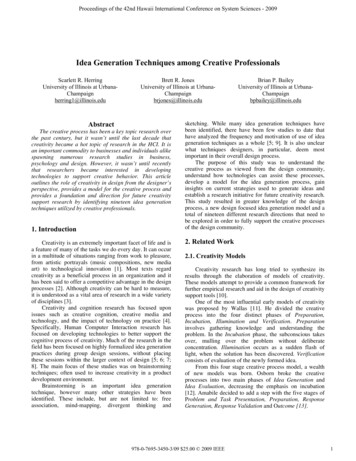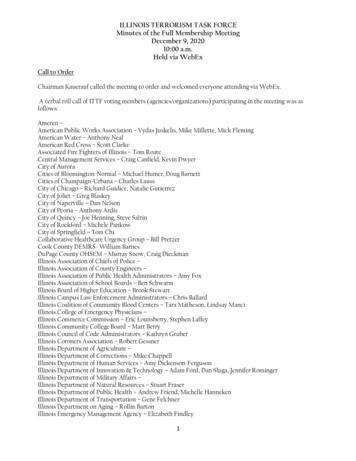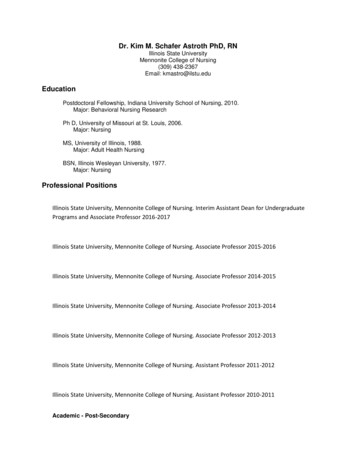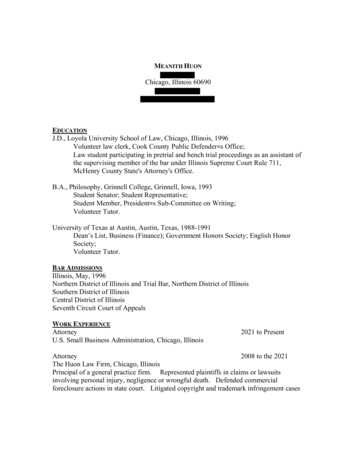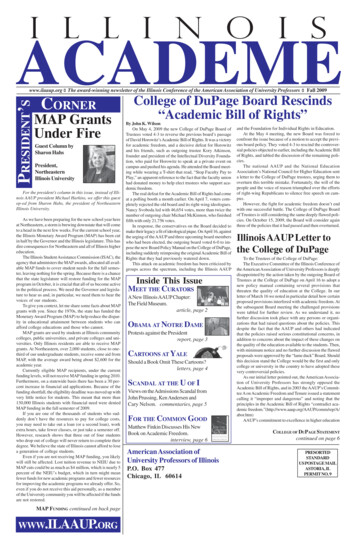
Transcription
I L L I N O I SACADEMEPRESIDENT’Swww.ilaaup.orgThe award-winning newsletter of the Illinois Conference of the American Association of University ProfessorsCORNERMAP GrantsUnder FireGuest Column bySharon HahsPresident,NortheasternIllinois UniversityFor the president’s column in this issue, instead of Illinois AAUP president Michael Harkins, we offer this guestop-ed from Sharon Hahs, the president of NortheasternIllinois University.As we have been preparing for the new school year hereat Northeastern, a storm is brewing downstate that will cometo a head in the next few weeks. For the current school year,the Illinois Monetary Award Program (MAP) has been cutin half by the Governor and the Illinois legislature. This hasdire consequences for Northeastern and all of Illinois highereducation.The Illinois Student Assistance Commission (ISAC), theagency that administers the MAP awards, allocated all available MAP funds to cover student needs for the fall semester, leaving nothing for the spring. Because there is a chancethat the state legislature will restore funding for the MAPprogram in October, it is crucial that all of us become activein the political process. We need the Governor and legislature to hear us and, in particular, we need them to hear thevoices of our students.To give you context, let me share some facts about MAPgrants with you. Since the 1970s, the state has funded theMonetary Award Program (MAP) to help reduce the disparity in educational attainment between students who canafford college educations and those who cannot.MAP grants are used by students at Illinois communitycolleges, public universities, and private colleges and universities. Only Illinois residents are able to receive MAPgrants. At Northeastern, over 2,000 students, close to onethird of our undergraduate students, receive some aid fromMAP, with the average award being about 2,600 for theacademic year.Currently eligible MAP recipients, under the currentfunding levels, will not receive MAP funding in spring 2010.Furthermore, on a statewide basis there has been a 30 percent increase in financial aid applications. Because of thefunding shortfall, the eligibility deadline was moved up withvery little notice for students. This meant that more than130,000 Illinois students with financial need were deniedMAP funding in the fall semester of 2009.If you are one of the thousands of students who suddenly don’t have the resources to pay for college costs,you may need to take out a loan (or a second loan), workextra hours, take fewer classes, or just take a semester off.However, research shows that three out of four studentswho drop out of college will never return to complete theirdegree. We believe the state of Illinois cannot afford to losea generation of college students.Even if you are not receiving MAP funding, you likelywill still be affected. Lost tuition revenue to NEIU due toMAP cuts could be as much as 4 million, which is nearly 5percent of the NEIU’s budget, which in turn might meanfewer funds for new academic programs and fewer resourcesfor improving the academic programs we already offer. So,even if you do not receive this aid personally, as a memberof the University community you will be affected if the fundsare not restored.MAP FUNDING continued on back pageWWW.ILAAUP.ORGFall 2009College of DuPage Board Rescinds“Academic Bill of Rights”By John K. WilsonOn May 4, 2009 the new College of DuPage Board ofTrustees voted 4-3 to reverse the previous board’s passageof David Horowitz’s Academic Bill of Rights. It was a victoryfor academic freedom, and a decisive defeat for Horowitzand his friends, such as outgoing trustee Kory Atkinson,founder and president of the Intellectual Diversity Foundation, who paid for Horowitz to speak at a private event oncampus and pushed his agenda. He attended the Board meeting while wearing a T-shirt that read, “Stop Faculty Pay toPlay,” an apparent reference to the fact that the faculty unionhad donated money to help elect trustees who support academic freedom.The real defeat for the Academic Bill of Rights had comeat a polling booth a month earlier. On April 7, voters completely rejected the old board and its right-wing ideologues.Nancy Svoboda led with 46,654 votes, more than twice thenumber of outgoing chair Michael McKinnon, who finishedfifth with only 21,756 votes.In response, the conservatives on the Board decided tomake their legacy a fit of ideological pique. On April 16, againstthe urging of the AAUP and three upcoming board memberswho had been elected, the outgoing board voted 6-0 to impose the new Board Policy Manual on the College of DuPage,including suddenly reimposing the original Academic Bill ofRights that they had previously watered down.This attack on academic freedom has been criticized bygroups across the spectrum, including the Illinois AAUPand the Foundation for Individual Rights in Education.At the May 4 meeting, the new Board was forced toconfront the issue because of a motion to accept the previous board policy. They voted 4-3 to rescind the controversial policies objected to earlier, including the Academic Billof Rights, and tabled the discussion of the remaining policies.The national AAUP and the National EducationAssociation’s National Council for Higher Education senta letter to the College of DuPage trustees, urging them tooverturn this terrible mistake. Fortunately, the will of thepeople and the voice of reason triumphed over the effortsof right-wing Republicans to silence free speech on campus.However, the fight for academic freedom doesn’t endwith one successful battle. The College of DuPage Boardof Trustees is still considering the same deeply flawed policies. On October 15, 2009, the Board will consider againthree of the policies that it had passed and then overturned.Illinois AAUP Letter tothe College of DuPageFOR THE COMMON GOODTo the Trustees of the College of DuPage:The Executive Committee of the Illinois Conference ofthe American Association of University Professors is deeplydisappointed by the action taken by the outgoing Board ofTrustees at the College of DuPage on April 16 to adopt anew policy manual containing several provisions thatthreaten the quality of education at the College. In ourletter of March 16 we noted in particular detail how certainproposed provisions interfered with academic freedom. Atthe subsequent Board meeting the challenged provisionswere tabled for further review. As we understand it, nofurther discussion took place with any persons or organizations that had raised questions about the policies. Thisdespite the fact that the AAUP and others had indicatedthat the policies raised serious constitutional concerns, inaddition to concerns about the impact of these changes onthe quality of the education available to the students. Then,with minimum notice and no further discussion the flawedproposals were approved by the “lame duck” Board. Shouldthis decision stand the College would be the first and onlycollege or university in the country to have adopted thesevery controversial policies.As our initial letter pointed out, the American Association of University Professors has strongly opposed theAcademic Bill of Rights, and in 2003 the AAUP’s Committee A on Academic Freedom and Tenure issued a statementcalling it “improper and dangerous” and noting that theprinciples in the Academic Bill of Rights “contradict academic or.htm)AAUP’s commitment to excellence in higher educationMatthew Finkin Discusses His NewBook on Academic Freedom.interview, page 6COLLEGE OF DUPAGE STATEMENTcontinued on page 6Inside This IssueMEET THE CURATORSA New Illinois AAUP Chapter:The Field Museum.article, page 2OBAMA AT NOTRE DAMEProtests against the Presidentreport, page 3CARTOONS AT YALEShould a Book Omit These Cartoons?letters, page 4SCANDAL AT THE U OF IViews on the Admissions Scandal fromJohn Prussing, Ken Andersen andCary Nelson. commentaries, page 5American Association ofUniversity Professors of IllinoisP.O. Box 477Chicago, IL 60614PRESORTEDSTANDARDUS POSTAGE MAILASTORIA, ILPERMIT NO. 9
IL AAUP Resolution on the Need to Protectthe Current Pension System for Employees ofPublic Colleges and UniversitiesNine of the 26 members of the Field Museum of Natural History AAUP chapter, standing in front of the museum’slegendary elephants in Stanley Field Hall.Museum Curators and the AAUPBy Patrick Ryan Williams, Bruce Patterson, MargaretThayer, and Ken Angielczyk, AAUP-FMNH 2009 officersMany university professors may wonder what museumcurators have to do with the professoriate. They may thinkof us as stodgy collectors, hoarding specimens away indark hallways. Especially in those disciplines in which specimen-based research is not a core component of scholarship, museum curators can often be overlooked as part ofthe academy. Yet, The Field Museum in Chicago recentlyformed its own chapter of the AAUP, and museum teachers,researchers, and scientists are proclaiming their role as educators and their concerns with academic freedom and governance in non-traditional settings for AAUP chapters.The Field Museum of Natural History is one of the threelargest academic research museums in the country, alongwith the National Museum of Natural History (SmithsonianInstitution) and the American Museum of Natural History.It is devoted to the discovery, documentation, and dissemination of information about the natural and cultural worlds.Its staff members discover through expeditions and research,document through encyclopedic collections and analyses,and disseminate this information through exhibits, educational programs and publications. Like all true museums,The Field Museum is built and organized around its collections, and is universally regarded as one of the world’s leading natural history museums, a peer among older and largermuseums in New York, Washington and London.The Field Museum is governed by a Board of Trustees,led by a President, and has a full-time staff of over 500 employees. The scientific backbone of the museum is its curatorial faculty, composed of 30-40 scientists distributed amongfour departments: Anthropology, Botany, Zoology, and Geology. Curators have career (tenured) appointments after atenure-track probationary period. Their performance is evaluated in four areas: research, curation, education, and service. The contribution to higher education, including teaching and chairing dissertation committees, is thus explicitlymentioned in the tenure policy, although without specificrequirements (e.g., 25% teaching or some number of coursesper year). Many aspects of curators’ research programs areones that might equally well take place at a university –indeed, some individuals come to The Field Museum fromuniversity faculties, and others move to universities fromthe museum.As part of their job responsibilities, most curators serveon the faculty of partner institutions. The Field Museumitself has collaborative agreements with area universitiesdating back to the first half of the 20th century, includingcollaborative graduate programs with the University of Chicago (1944), the University of Illinois (1987), and Northwestern University (2001), and individual curators have appointments at a number of other institutions and serve additional programs as readers, outside members, or externalexaminers. Curators also teach classes, chair or serve onPhD committees, and mentor undergraduate, graduate andpostdoctoral scholars as part of these programs.It quickly becomes clear that museum curators have agreat deal in common with their colleagues in universitysettings. Indeed, in university museums, curators are mostoften members of the academic departments in which theyhold tenure. The large, independent research museums likethe Field are somewhat unusual in that they are not part ofa university structure, but their faculties are very much apart of the professoriate. Our concerns mirror those of ourcolleagues in universities, although we have multiple administrations with which we interact in the course of ourprofessional responsibilities.The formation of a chapter of the AAUP thus constitutes recognition by the curatorial faculty of the importanceof the professoriate’s ideals. With over 80% of the museum’sfull-time tenured and tenure-track faculty listed as chartermembers, the chapter has strong endorsement. The chapter’scharter statement, appended here, expresses the aspirationsand goals of a unified faculty, self-determined to preservethe conditions necessary to promote higher learning andacademic freedom in the academy.American Association of University ProfessorsField Museum of Natural History ChapterCharter StatementIndividual curators and departments at The Field Museum have long built successful relationships with areauniversities, through teaching, undergraduate and graduate student training, and program development. Theseeducational enterprises, as well as museum-based postdoctoral training, have not yet been fully translated intowidespread public recognition of the regional leadershiprole of the Museum’s science faculty in the educationand advanced training of our nation’s future scientistsand science administrators.The formation of the new AAUP Chapter at the Museum thus unites our diverse in-house science facultyunder a shared set of common goals, giving the Museuma unified voice when we are communicating — and negotiating — with universities, granting agencies, foundations, and other organizations on matters concerningboth teaching and the advancement of science education generally. This solidifies our standing in local, state,and federal initiatives in support of undergraduate, graduate, and post-graduate science education.The professionalization of the Museum’s scientificfaculty through the establishment of the new AAUPChapter thus builds on our past educational successes,and prominently enhances our educational goals andresearch mission by more fully realizing the contributions that Field Museum scientists have made and willcontinue to make to higher education.Adopted April 18, 2009*Whereas, The State of Illinois has significantlyunderfunded its pension systems by legislative and gubernatorial decisions from FY 1981 to FY 1991 and FY 2006 toFTY 2009 creating an unfunded liability of over 54.4B as ofJune, 2008, the largest dollar amount in the nation;Whereas, Illinois public college faculty and staff are notcovered by social security that requires an employer FICAtax contribution of 7.65 % which means that the state iscontributing little more than the amount required for socialsecurity and Medicare in contrast to other states that coverall or half the cost of contributions to retirement systemssuch as TIAA/CREF in addition to the FICA amount;Whereas, Illinois public college faculty fall behind theirIBHE comparison peer groups in benefits;Whereas, Participants have continually paid their fullshare to the retirement system and the interest on their contributions served to decrease the state’s liability for pension shortfalls;Whereas, Failure of the state to make its mandated contributions is the preeminent cause of the shortfall full funding of the state pension systems;Whereas, There are numerous editorial calls for the moreof pension costs to be assumed by future employees and aproposal by the Governor would exacerbate the gap in benefits between Illinois institutions and other colleges anduniversities competing to attract new or hire away top quality faculty;Whereas, The budget proposal offered by the governorcalls for rewriting existing law on funding of pensions tocontinue the underfunding of state pension systems; andWhereas, Private universities and colleges may followany precedent set by the state in transferring costs of benefits (including health insurance) to their faculty and staff;Resolved, That the American Association of UniversityProfessors of Illinois calls upon the legislature and governor to recognized the necessity of fully funding its pensionobligations in amounts established in existing state law;Resolved, That the legislature and governor recognizethe negative impact on retention of faculty and staff byrequiring a 2% increase from current employees, thus further widening the gap in salaries and total compensation ascompared to peer institutions as documented by AAUPsurveys and current IBHE reports available to prospectiveand current faculty;Resolved, That the state undertake the necessary stepswhich must include revenue enhancement to enable the stateto remain solvent and meet its obligations to participants inthe pension system, andResolved, That the AAUP of Illinois urges its membersand faculty, staff and students to contact legislators personally to stress the need to deal with this issue of unmetpension obligations.Illinois AAUP Resolution on the Need toEnhance State RevenueAdopted April 18, 2009*Whereas, The State of Illinois has had a consistent structural deficit in revenue for the last several years, one currently estimated to range between 4% and 5% or 2.5 Billionto 4 Billion dollars;Whereas, Illinois has reduced sharply its support of fouryear public colleges causing significant increases in tuitionlevels and never funded its community colleges at the levelenvisioned in state law;Whereas, Higher education, public and private, and theIBHE have established affordability as a primary goal toensure student access but tuition increases have not beenmatched by increases in MAAP and other scholarship grantand loan programs; andWhereas, The state is lagging in paying its bills by asmuch as six months, threatening the economic well-being ofbusiness relying on state reimbursement for goods and services including medical and prescription costs;Resolved, To ensure adequate support of Illinois highereducation, the American Association of University Professors of Illinois calls upon the legislature and governor toadopt legislation to ensure a large, permanent increase instate revenue; andResolved, That the AAUP of Illinois urges its membersand Illinois citizenry to contact legislators personally tostress the need to achieve a sustainable increase in staterevenues.*The information in this resolution is current as of thedate of adoption of the resolution. Many changes relativeto proposed legislation will occur before adoption of astate budget. Individuals need to monitor events in SpringIllinois Academe was named as the AAUP’s best state conference newspaper in tabloidfield and continue to express their views to the legislatureformat at the 2009 Annual Meeting. Congratulations to all who make this paper possible.and �——————————— Illinois Academe · Fall 2009 · Page 2 �—————————Illinois Academe Award Winner
Academic Freedom for a Free Society: The AAUP Summer InstituteBy Todd PriceOver the summer, hundreds of AAUP members representing university chapters from around the country gathered at Macalester College to discuss and deliberate overissues critical to their collective profession, namely, how toprotect, preserve and advance the aims of academic freedom in an age of not only economic blight but continualencroachment on the university mission by a range ofadversarial forces.The institute included several exceptional workshopsaddressing a varied number of critical issues, providing theknowledge and skills needed for members to be able to takeback to their respective chapters the important message thatfaculty, even during economically dubious times, maintainthe right to participate fully in decisions impacting their university.I spoke with the organizers and brought back information for my own chapter information concerning academicfreedom, promotion and tenure, shared governance, and faculty compensation and welfare. In this essay, we will hearfrom the president, secretary and one of the conference organizers, what are the most compelling observations of whatwe are facing, as far as faculty are concerned.Cary Nelson, the AAUP President from the Universityof Illinois at Urbana-Champaign, mentioned the highlightsof the Summer Institute:Nelson: “I’m here in Minnesota, at our annual SummerInstitute which is a wonderful training institute that we do.We teach people how to analyze their university budget,we teach people how to reinforce shared governance ontheir campuses, we give instructions on collective bargaining, we give instruction, classes, on how to strengthen yourlocal chapter, and we do things like take cruises on the riverand have some fun at the same time! It’s really one of thebest things we do!”He was followed by Michael Mauer, AAUP Director ofOrganizing and Services, speaking about the scope ofAAUP across the country:Mauer: “We’ve got over 400 chapters on campuseswhere there is no union but we’ve got an AAUP chapter,they really run the gamut, but in very many of those chapters, there are enough members and there are enough committed faculty working in the chapter that decision makingdoesn’t happen without faculty input and in very practicalways it makes huge differences in the lives of faculty atmost campuses. So for example compensation decisionshave to happen after appropriate dialogue with the facultynot just by unilateral fiat from the administration.”Finally, I spoke with Gary Rhoades, the Secretary ofthe AAUP regarding the manner in which administrationkeeps faculty acquiescent to receiving just compensation:Rhoades: “So often in these situations the administra-tion taps into the kind of general feeling the population has,about the faculty has about hard times, they vote what’sgoing on in the larger economy, they vote what’s going onwith state deficits, and by virtue of those largely societyhard times, they suggest that the institution itself is experiencing financial exigency at levels of financial crises thatcall for the faculty to give back in a variety of ways in furloughs, pay freezes even or pay reductions and so whatthis session was designed to do was take the empirical dataand basically to puncture that argument and show that infact higher education institutions are in much better shapethan we’re often led to believe, that administrations whenthey frame their institutions as being in deep financial crises are not utilizing the financial practices and measuresthat an accountant would, finance professor would, or someone who understands higher education financing would.”These interviews continue on a YouTube post calledAAUP Interviews, and really serve to provide a conciseand effective summary of the most important issues thatevery faculty should be aware of in 2009 and the yearsbeyond.For further comments and questions, please feel free topost questions and observations to: Todd Alan Price, National Louis University AAUP Chapter President,tprice@nl.edu or follow my new blog, Technology for Democracy at: http://tprice1963.blogspot.com/Obama’s Speech at Notre DameProtested By Conservative GroupsBy John K. Wilson“SCANDAL: Obama to Deliver Notre Dame Commencement.”That was the headline in an email from the CardinalNewman Society (CNS), announcing their opposition tohaving President Barack Obama give the commencementaddress at the University of Notre Dame on May 17. Theyeven created a website to “Help Stop the Scandal at OurLady’s University.” According to the letter, “It is an outrageand a scandal that ‘Our Lady’s University,’ one of the premier Catholic universities in the United States, would bestow such an honor on President Obama given his clearsupport for policies and laws that directly contradict fundamental Catholic teachings on life and marriage.”The Cardinal Newman Society is a right-wing Catholicgroup that, often successfully, lobbies Catholic colleges tocensor liberal views (needless to say, it’s never called forbanning conservative supporters of the death penalty fromspeaking on campuses, even though they violate Catholicdoctrine).The group even attacks conservatives. Quincy University commencement speaker (and well-known conservativeradio legend) Paul Harvey withdrew in 2003 after the group’scriticism of his pro-choice beliefs. Reilly called upon Catholic University of America in 2006 to ban politician Bob Caseyfrom speaking on campus. Although Casey is a Catholicwho opposes abortion rights, Reilly proclaimed that “BobCasey has no business delivering a lecture on public morality” because Casey does not want to ban contraceptives.The Cardinal Newman Society demands that all Catholiccolleges impose an unprecedented regime of censorship; in2005, the Society presented a list of 18 professors at Catholic Colleges that the group believes should be fired becausethese professors took a position on the Terri Schiavo casecontrary to that of the Vatican. These attacks have had astrong influence on Catholic Colleges, and administratorsfear being the next target of the group.Perhaps the most dramatic case of the Cardinal NewmanSociety’s attack on academic freedom came at the University of St. Francis in Chicago in spring 2004. Dr. NancySnyderman was dis-invited from giving the commencementaddress four days before graduation after a campaign againsther by the Cardinal Newman Society. A surgeon, author andformer ABC medical correspondent (she’s now featured onNBC Nightly News), Snyderman, who is personally opposedto abortion, had mentioned in a medical report on ABC’s“Good Morning America” on Oct. 30, 1997 that some doctors recommend “selective reduction” via abortion for awoman pregnant with septuplets because of the high risk inhaving seven babies. A letter to Snyderman from the university read, “The university recently received information containing comments by you on the topic of abortion, andthese comments appear to be contrary to the teachings ofthe Catholic Church. As a Catholic university, we have nochoice but to rescind our invitation.” When a journalist anddoctor is banned from a campus for accurate reporting onabortion issues, it indicates how far the repression of freedom at Catholic colleges has gone.Another form of retaliation used by the Cardinal NewmanSociety is to remove institutions from official designation asCatholic colleges, hurting their recruiting and fundraising.In 2003, the Cardinal Newman Society was able to pressureto have Marist College removed from the list after Eliot Spitzerwas allowed to speak at its graduation. In 2005, MarymountManhattan College was similarly de-recognized after it allowed Hillary Clinton to speak. This kind of intimidationforces colleges that wish to remain Catholic to censor thespeakers allowed on their campus on the orders of a rightwing splinter faction.But the group, although adept at getting publicity, is faroutside the Catholic mainstream. The Association of Catholic College and Universities denounced the Cardinal NewmanSociety for making accusations that are “distorted, inaccurate and in some cases simply untrue.”Thanks to Reilly, Eve Ensler’s “The Vagina Monologues”is the most frequently banned play in America. The CardinalNewman Society has taken credit for “a marked decline inplanned performances of the Monologues” at Catholic colleges. In recent years, the play has been banned at the University of Portland, Iona College, the College of New Rochelle, Loras College, Rivier College, Xavier University (Ohio),Catholic University of America, Providence College, LoyolaUniversity of New Orleans, Emmanuel College, St. AmbroseUniversity, St. John’s University, St. Joseph’s College (Indiana), Wheeling Jesuit University, Alverno College, Collegeof Saint Mary (Nebraska), Edgewood College, FontbonneThe Academic FreedomControversy at Notre DameThe Indiana Conference of the American Associationof University Professors expresses its support for University of Notre Dame President the Rev. John Jenkins in standing by the university’s decision to invite President BarackObama to speak at its May 17 commencement. We areconcerned by the efforts of external groups to preventPresident Obama or any other invited guest from speakingon campus.For almost a hundred years, the AAUP has defined forcolleges and universities the meaning of academic freedom through its policy statements and procedural guidelines. We hold that the freedom of faculty and other members of the campus community to conduct research, publish, and exchange ideas, especially highly controversialones, without outside interference or censorship is thelifeblood of the university and is essential to the production and dissemination of knowledge. The fact that American universities have such an enviable world-wide reputation is in no small part due to our practice of academicfreedom.While the AAUP recognizes that religious colleges anduniversities have the right to propagate their special faith,these institutions must also protect and model free inquiryand open dialogue. Notre Dame’s embodiment of thesevalues has helped earn it a reputation as one of the premierCatholic universities in the United States. In 1967, NotreDame President the Rev. Theodore Hesburgh and otherleaders of Catholic colleges and universities proclaimed inPresident Barack Obama spoke at the University ofNotre Dame in May.University, Loyola Marymount University, Marquette University, the University of St. Francis, and several other institutions. Censorship has discouraged students from trying to organize performances at many other colleges.It’s time for Catholics and anyone concerned about academic freedom and free speech in this country to speak upand say that the Cardinal Newman Society is wrong. Thereshouldn’t be repression of different views at Catholic colleges. And Notre Dame should be proud that Barack Obamahas chosen to honor its campus by giving the commencement address. Although the Cardinal Newman Society wasunsuccessful in its efforts to bar Obama from speaking, thepower of its agitation against academic freedom creates achilling effect at Catholic colleges.the Land O’Lakes stat
with one successful battle. The College of DuPage Board of Trustees is still considering the same deeply flawed poli-cies. On October 15, 2009, the Board will consider again three of the policies that it had passed and then overturned. Illinois AAUP Letter to the College of DuPage To the Trustees of the College of DuPage:
